
|
||
|
Portland art blog + news + exhibition reviews + galleries + contemporary northwest art
|
||
Interview with Storm Tharp 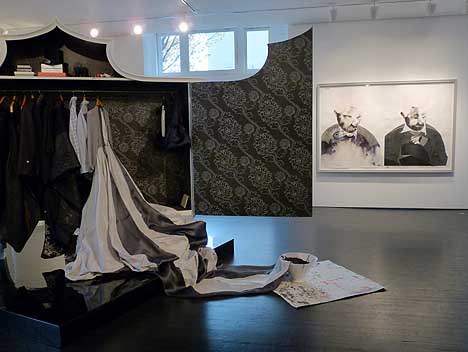 Installation view Arm & Arm at PDX Contemporary Art 2008 (photo jeff jahn) The train of a silken gown wicks up India ink from a bowl on the floor. Six portraits of Diane Keaton, shifting like spastic film stills, hang in a grid next to two quietly glowing color field paintings. Across the room is a monumental series of panels bearing Ruscha-like text: "SIREN SOUND," and "WHOSWHO." Abutting this arrangement are a lusciously expressive ink portrait and a video sequence of banal domestic moments tinged with everyday beauty. 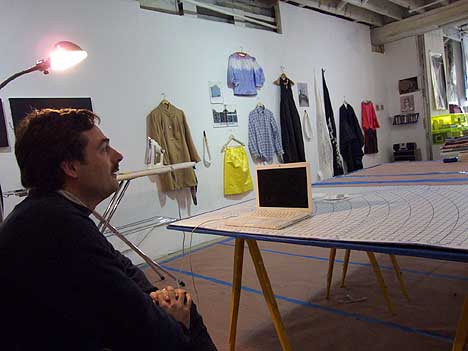 Storm Tharp in the studio, October 2008 (photo jeff jahn) This is "Arm & Arm," Portland artist Storm Tharp's latest solo exhibition, which opened on November 1st at PDX Gallery. It displays an artist in flux: working with newfound focus and confidence, but never resting in the comfortable territory of past success. Tharp is the latest addition to the handful of Portland artists who exhibit internationally. Moreover, he has the rare status of having earned this reputation from Oregon, showing repeatedly at PDX Contemporary Art and in local group shows. Tharp, a native of Ontario, Oregon, has cultivated a solid local following for his diverse oeuvre encompassing everything from quirky urbane portraiture, giant sculptural eyelashes, and handmade clothing. Despite shifting media, Tharp maintains a consistent technical facility (the clothing in the centerpiece installation of the current exhibition is fastidiously tailored and wearable) and an aesthetic continuity that owes more to Japonisme and classic cinema than to any regional art movement. 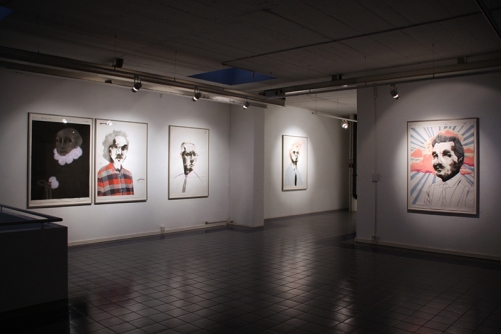 Tharp at Galerie Bertrand & Gruner, Switzerland 2008 "We Appeal to Heaven," Tharp's last solo offering in Portland, in 2007, caught the artist at his most consistent: a gallery of uniformly sized ink portraits and some peripheral text pieces. It was a successful cementing of his promise, and many speculated that he'd found 'his thing.' At a solo show that closed last month at Galerie Bertrand & Gruner in Switzerland, as well as a two-person show at Nicole Klagsbrun in New York this month, Tharp has continued to develop and display this tangent of his work. But in "Arm & Arm," Tharp ventures into other realms, exploring a newly intimate and familial conceptual terrain. 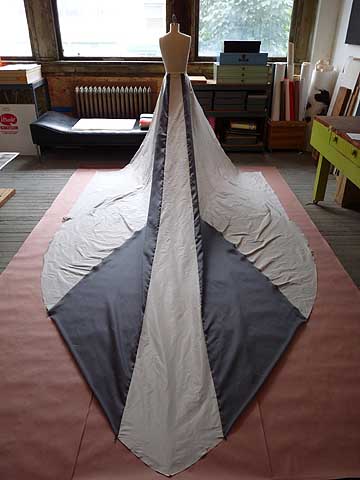 Tharp's studio, October 2008 (photo Jeff Jahn) The show makes me think that Tharp is ready for a bigger space: the works are large and disparate, and command more room for reflection than even the airy PDX Contemporary Art can offer. Some of the most beautiful moments arise in the space between works-the reflection prompted by the urge to create thematic connections- and I look forward to seeing Tharp's museum debut. The unexpected combination, in these recent works, of threat and sweetness begins to build an atmosphere of sunlit noir. 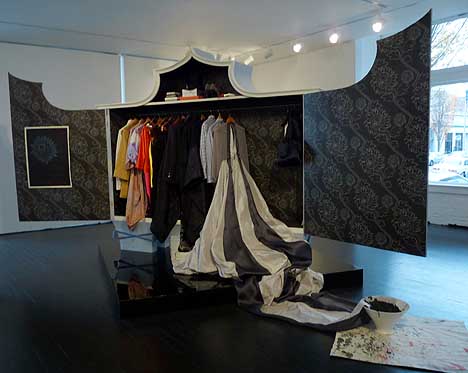 The Dresser (sftkbdp) When I talked to Storm Tharp at his Southeast Portland studio, he was putting the final touches on "The Dresser (sftkbdp)," a monumental piece of furniture flung open to reveal the private lives of a fantasy couple. Dress shirts, formal wear, and hats fill the wardrobe, which is modeled on a design by the Austrian Dagobert Peche. A vase of feathers and a text-covered plug of drywall are among the idiosyncratic details that populate this peephole into an imaginary relationship. Smaller cities can be cruel to those who find success. But Tharp's characteristic affability and charm, along with his sincere work ethic, have won him the admiration of any Portland artist I've talked to. In a nearby café, Tharp gave me some insight into his busy creative life, along with some tips about his hometown. RP: Over the past few years you've gone from being a local artist- showing almost exclusively in Portland for over fifteen years- to quitting your job at Wieden and Kennedy to make art full-time. What has this been like? ST: Well, I've been doing something that I've wanted to do for a long time, and it feels good to work it out, you know? It's a lot of work. RP: Was this a sudden choice, like "Hey, I want to take this risk-" ST: No. I've been working toward this since I was a kid. I always knew that I'd have to have a job, but I also always knew that I wanted to be an artist. And not really anything but an artist. 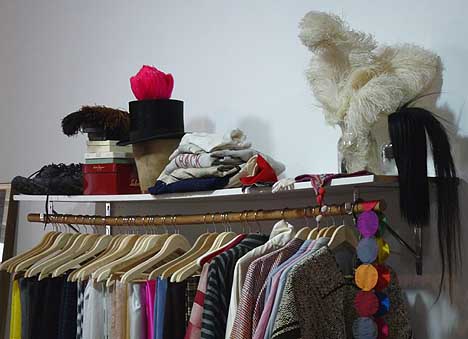 Tharp's studio, October 2008 (photo Jeff Jahn) Well, when I was younger, I wanted to be a fashion designer. That's probably the only job that I thought about- that I wanted, but decided not to do. I chose art over that. I make reference to that inclination in the work I have just completed. It's an installation of a dresser, and it includes many garments that I made by hand. I think, on a few levels, that work is about the life I didn't choose. My life as clothing designer. My life as a married man. Etc… It was really just a matter of time before I developed the courage to walk away from my job. After college I realized that I was pretty much unemployable. However, within my BFA, I concentrated on photography. The relationship between photography and design was clear. Magazine work was interesting to me, and I spent time at Interview Magazine in 1990. I thought maybe I could be a photo editor. In 1994, in Portland, creative jobs were few and far between. Or I didn't know where they were. Wieden and Kennedy was an entity that I had heard about and I knew that they did a lot of photo-based projects- not just advertising- but that they had a photo library and stuff like that. I went from working in a deli to working for them, and that turned into full-blown art direction eleven years later. But I always pursued art while I was working on paying the rent, so it was really about just eliminating one thing while keeping the other thing intact. I still freelance. I still haven't figured out how to make art the lucrative bread and butter. I don't have the credentials to teach, so advertising work is not something I take for granted. 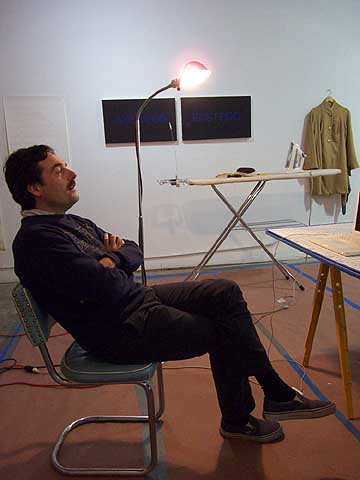
I don't know how to quite explain what it's done to me otherwise, though. I mean, the creative process continues to be like the dark arts, in weird ways. It's just like a battle, in the studio, to keep myself on top of all of the doubt, and all of the horrible feelings that come up constantly. Creatively, I don't feel like my life has changed, but my practice has changed, and it's still hard. It hasn't made it easier; it's made it harder. But then, that is kind of contrasted with the opportunities that have presented themselves. And that…well, that has also made it harder because you have to work to not fail at those opportunities. So I've been testing myself to rise to the occasion. So, if anything, it's been more difficult than ever. I changed studios in January. I used to work in my garage. So that has been huge. It's a very fitting space. Except there's no heat. It's very cold in the winter. RP: Are there aspects of what you were doing at Wieden and Kennedy that are now finding home in your work? ST: I used to think I was working with two very different lobes of my brain, and they were not influencing each other at all. In a relative way, that is true. The amount of people that you have to impress and to get approval from in advertising is not anything like working for yourself and being the only person that gets to decide anything. But I think I was incorrect, in the past, in saying there was no sort of meiosis. There apparently was, and I feel it more now than ever. One of the hardest things to do is to force yourself to conceptualize ideas around advertising, with a partner, and a larger team approving those ideas. It's embarrassing beyond…I can't quite explain to you how hard it is to say that stupid idea, and you have to say that bad idea to know that is not what you want to do. There is probably something very beneficial to me, as an artist, to have gone through those exercises because it does to force me, in my own work, to also say the bad idea. The part that some people might think would influence me- all the rapid eye movement and the culture candy- that doesn't work in my studio at all. I like to find one thing, or maybe just a small entrée of five things, and really investigate just those things and not worry about all of the other stuff. And that's very different than advertising. Advertising is about everybody, all the time. RP: Well this leads to another question: What is your editing or evaluation process in your work? How do you decide what to present to the world? ST: Sometimes it's not about the editing. Sometimes it's just about landing in the right place and you're like (sigh of relief), I love that! But that doesn't happen very often. More often than not you have to struggle to achieve it. 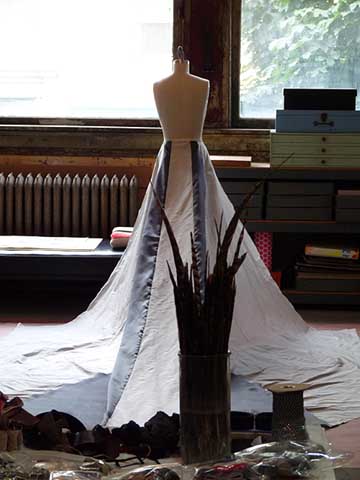 Tharp's studio, October 2008 (photo Jeff Jahn) What I find really disturbing is when the artwork begins to have a life of its own - when I am so freely putting ideas to paper, that I get kind of lost.. Like, "Is this me, or is this not me? Is this a fantasy of me?" I find myself, on any given day, sort of confused about what it is that is meaningful. I tend to be somebody that would rather find the right answer than move onto another task or question or possibility. It's a real problem. So, in this way, I edit as I go. I think I've been emphasizing, the last five years, to know who I am, and to edit based on that. RP: It seems like, at least with your ink portraits, that that would be a really unforgiving way to work… ST: It is unforgiving. But I found a way to change it. I'm a big proponent of the right materials. And the right materials for me are the right kind of paper, and really beautiful ink. The ink is the fun part, and it gets to do all the great stuff with water. But the paper is like the foundation. The paper actually does allow me to make corrections. I discovered in the last year that I can actually take low-grade sandpaper and erase a mistake. I can't erase a bad idea. But I can erase a mistake. I kind of like mistakes, you know? But bad ideas…are awful. And that process is really unforgiving of bad ideas. A bad idea might be painting the entire background the wrong color. Or giving a character a posture that is wrong and to correct it involves an unbelievable amount of reconstructive surgery. It is like oil painting that way; you have to really start over again. But I have found a way not to have to destroy them. I can re-work them, but only once or twice. It's nice to know that I can bring the paper back to white. RP: It seems like there is an element of technical confidence in all of the media you work in. Do you practice with new media before you begin a project? Are there materials you would like to use that you haven't tried yet? ST: I don't practice. Well, I practice in the trajectory of making things. I dive in and make things, and it's through that making that practice is achieved. RP: Have you been making videos for a while? ST: No, I haven't been making videos for a while, and I am not a video maker. I have made three, and the amount of technical assistance I have needed from collaborators is pretty substantial. But I love video. Celluloid history is a big part of what I make: Performances. Becoming a character. Turning into something…the fantasy of all that. This is like the basis of every single thing I've made. So, making films would appear to be a logical step. I've been thinking that the combination of the clothes-making and the video-making part of the show are just two of the arms of making a movie. And I wonder if I'm leaning towards that. I hope not. I don't want to make a movie, a feature movie. But I wonder if that's where it's all going. I'm more interested in casting a movie, or doing costume design. But directing a movie? No. 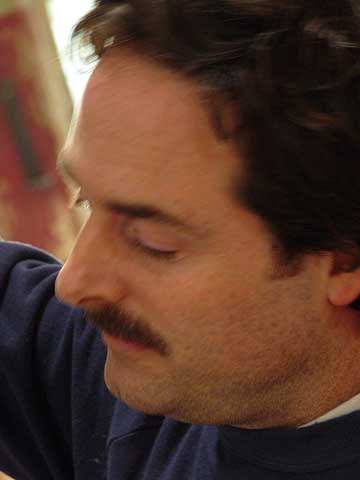 But I think that answers your question, in a way. I would like to be better at making video. Sculpture, in many of its forms, is something I would also spend more time with. I would probably- I don't know, prefer to spend more time with oil paints than to work with bronze. RP: I've heard you mention literary influences before, such as Vladimir Nabokov and Marilyn Robinson. What are some literary influences that are coming out in the work you're making now? ST: Lolita continues to be a huge influence. I had never read it because I thought I knew it- I thought I'd already been there. I read it less than a year ago and I completely freaked out. The language of Nabakov is awesome- I was already aware that he was a wordsmith that way. It's the mirror he holds up to contemporary society that is just astounding to me. The combination of formal technique and maniacal storytelling is beyond traditional praise. It's like nothing else. I read "The Road," which I thought was really good. I read a book called "Samedi the Deafness," by Jesse Ball. A really strange book, but I liked it a lot. I have a really tall stack next to my bed. Huckleberry Fin is on top. It's not the book for me right now, but I want it to be. I want it to be like some Velasquez painting, and to make all other books make sense. But I can't get to it. James Purdy. I want to know about James Purdy. And I have a biography about Lincoln Kirstein that I think is probably amazing. And I have the awful, filthy, disgusting Marlon Brando biography that I just open up to any page and… it's so filthy. It's unbelievable… RP: Your work contains elements of surrealism and also of pop art. But it seems not to be so grounded in contemporary popular culture as something more nostalgic or dated. Is there any truth to that assessment? Do you consider yourself to be making pop art? 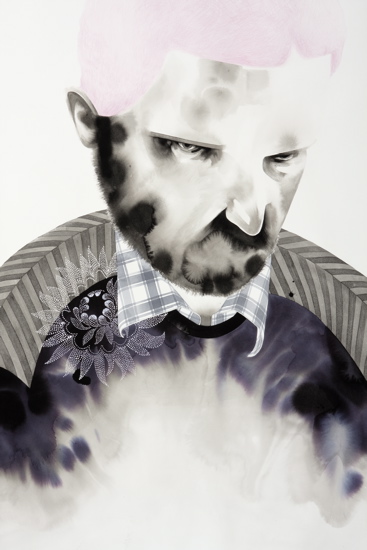 Twins at a Funeral, detail (left), 2008 ST: I do. I do think that it's pop art but you're right in that it also isn't. I don't think that the current popular vernacular is appropriate for the kinds of portraits that I'm making. If I were to pick a very plain person, that person might be able to work, because they might look like an August Sander photograph or something… But I think if my portraits start to become more referential of what we are now…I think they would die. I think they would fail. I don't think it would work. I don't think that's what they are about. It's not just the past. Sometimes it's a bit of the future. There's a little bit of the Terry Gilliam quality, of taking something old and making it new and revitalizing it. David Lynch does it, too. There's a little bit of the future involved- there's a little bit of something else. It's hard to reference the now- Britney Spears, or Barrack Obama or Hilary Clinton, or a number of people that make up our popular consciousness- I don't think that's what my work is doing. So in that regard I'm not a pop artist. But if the work is confused as such, I think it's because the portraits look familiar. And they do reference a certain kind of glamour, a self-conscious glamour that is very sort of 'magazine-world.' It looks like a presentation of fashion or tabloid culture, but that's not what they are. It looks like pop art but it's not. RP: What keeps you sane when you're doing so much studio work? How do you stay grounded? ST: I like to go running in Forest Park, Monday through Friday. I'm a better artist and person when I can go running five times a week. I also enjoy food and I love cooking for my friends so much, and that keeps me sane. I go to great pains to make things in the kitchen. It could be a day when the studio was really awful and I would loved to be cooked for, but when I get the opportunity I'll still want to cook. It's a completely different kind of pleasure. To concoct something, within a matter of hours, is awesome to me. I cook a lot. And friends. I have great friends. I love to be with them. I like to hear about what they're doing. I like their lives, and it's totally awesome to know really great people and to be able to leave yourself and be with them for a little bit. And that's not to say that I don't completely monopolize the conversation with my life, but I try not to…if I try to be sane and know what's going on with the world, I hang out with people that have something to tell me about what they're doing. So, running, food and friends. That was easy. And wine. I'm a big wino (laughs). 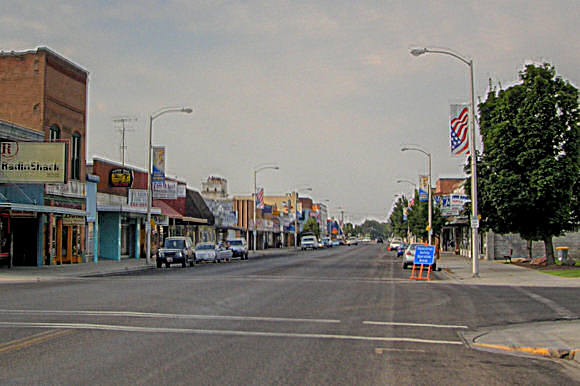 Ontario, Oregon RP: So you're from Ontario, Oregon. Last time I was there it was during a huge dust storm, with tumbleweeds and everything, and I just didn't know where to go. Next time I'm passing through Ontario, what should I do? ST: The thing I would do in Ontario is go to Burger West. It's a drive-in. They have this hamburger called the Ranch Hand. It wouldn't win a hamburger contest or anything, but it's a really peculiar hamburger and it's really good. Secondly, I'd go to Casa Jaramillo and have tacos and enchiladas. Third, I'd drive out to Malheur Butte, which is a really beautiful…butte. Not a mountain. It's a butte. It's a strange thing to have a butte. I guess a butte, geologically, would be like a small mountain? RP: A flat mountain? ST: It's not flat. It's a small mountain. RP: Does 'butte' mean there are no other mountains around it? ST: Yeah. There's nothing around it. I would go to Malheur Butte. And there's a big water irrigation pipe that runs across it, that has every single person's name in graffiti on it, from the past 30 years, and every expletive about who that person is next to it, including some of my family members. RP: I was struck by the overall themes of domesticity in your new show. Whereas the last group of works seemed like a group of strangers (despite familiar attributes)- a jury panel, perhaps- the work in "Arm in Arm" feels more intimate. Any thoughts about that? ST: I'm not sure exactly where that began. I mean, I was making a concerted effort to think about American culture and how it was moving. And how it was accelerating yet possibly not improving. American culture has been strange and unsettling for some time now - but it reached this unavoidable level of absurdity in the past year. From The War to Brittney Spears. From the feuding Democratic primaries to the fact that my grandmother has a Facebook account. Polar ice caps…I was constantly blown away. There is a palpable hum. A rev. Granted, these thought are filtered through a personal lens and, in this way, I automatically started thinking about my loved ones and my family. Almost like a preservationist with a sense of worry. I wanted to keep things close and take care as much as I could. In this regard, I began to gravitate towards ideas about keeping company, family, relationships and disappointments. Amorous love, loneliness and confusion. These are thoughts that I have toyed with before in my work - but in the past I have used them to express a kind of personal dilemma or a spiritual shortcoming. These thoughts shifted into larger cultural preoccupations as well as domestic, familial concerns. In a very quiet way, Seurat's drawing, "Embroidery (The Artist's Mother)" - had a deep impact on the way the work came together. I was on a plane returning home. I had just seen the Seurat Drawings at MoMA. I was looking out the window listening to a soundtrack featuring a piano solo - the clouds outside. I thought about my mom. I thought about that drawing. I felt rather desperate. Posted by Ryan Pierce on November 05, 2008 at 9:39 | Comments (2) Comments I agree. The Ranch Hand is a stunning feat of burger engineering. Posted by: mummycop I used to think it was a completely romantic idea that every artist seems to lack heating in their studio. Making art shivering, despite constant shivering. Now after spending time in my own unheated studio, I realize that is just a stupid thought. There's nothing glamorous or romantic about attempting to use a jigsaw with frozen fingers. Looking forward to seeing the show tonight. There is no doubt it will be amazing. Posted by: Calvin Ross Carl Post a comment Thanks for signing in, . Now you can comment. (sign out)
(If you haven't left a comment here before, you may need to be approved by
the site owner before your comment will appear. Until then, it won't appear
on the entry. Thanks for waiting.)
|
| s p o n s o r s |
 |
 |
 |
 |
 |
 |
 |
 |
 |
 |
 |
 |
 |
 |

|
Site Design: Jennifer Armbrust | • | Site Development: Philippe Blanc & Katherine Bovee | |


![[TypeKey Profile Page]](http://www.portlandart.net/nav-commenters.gif)